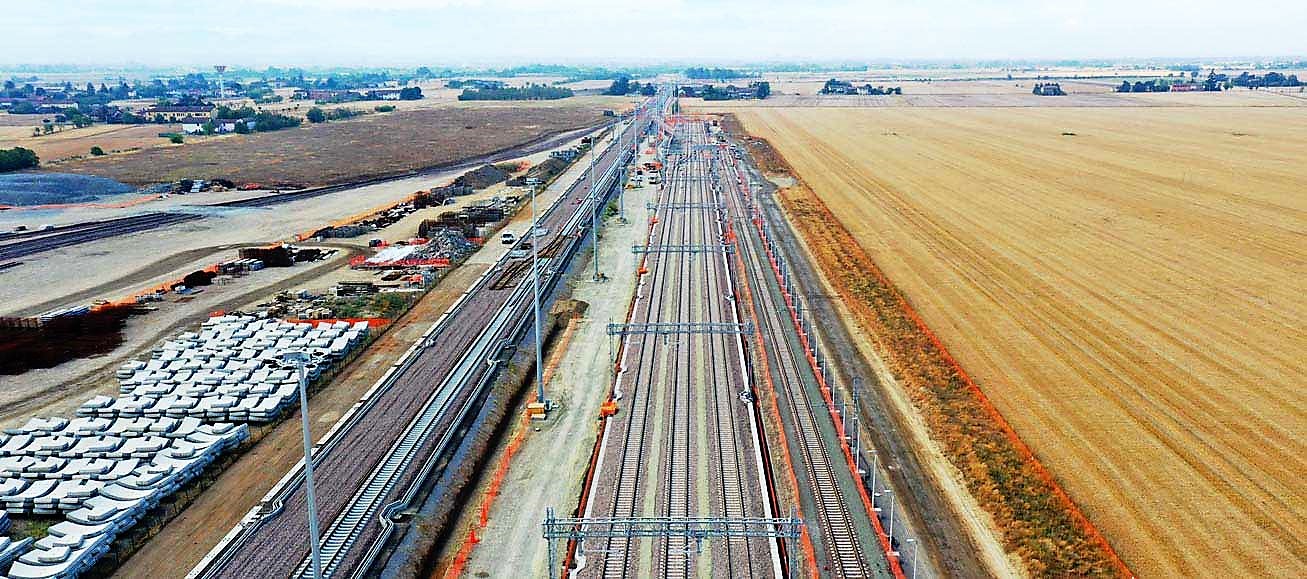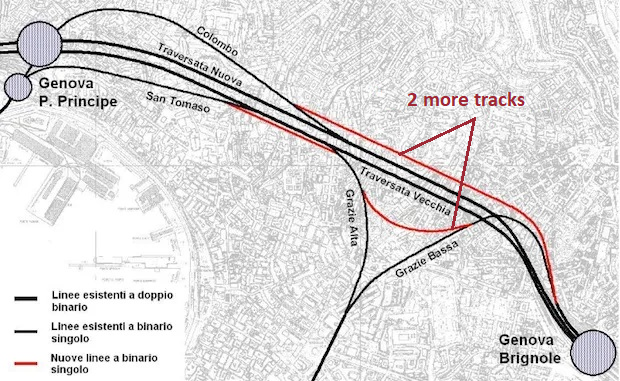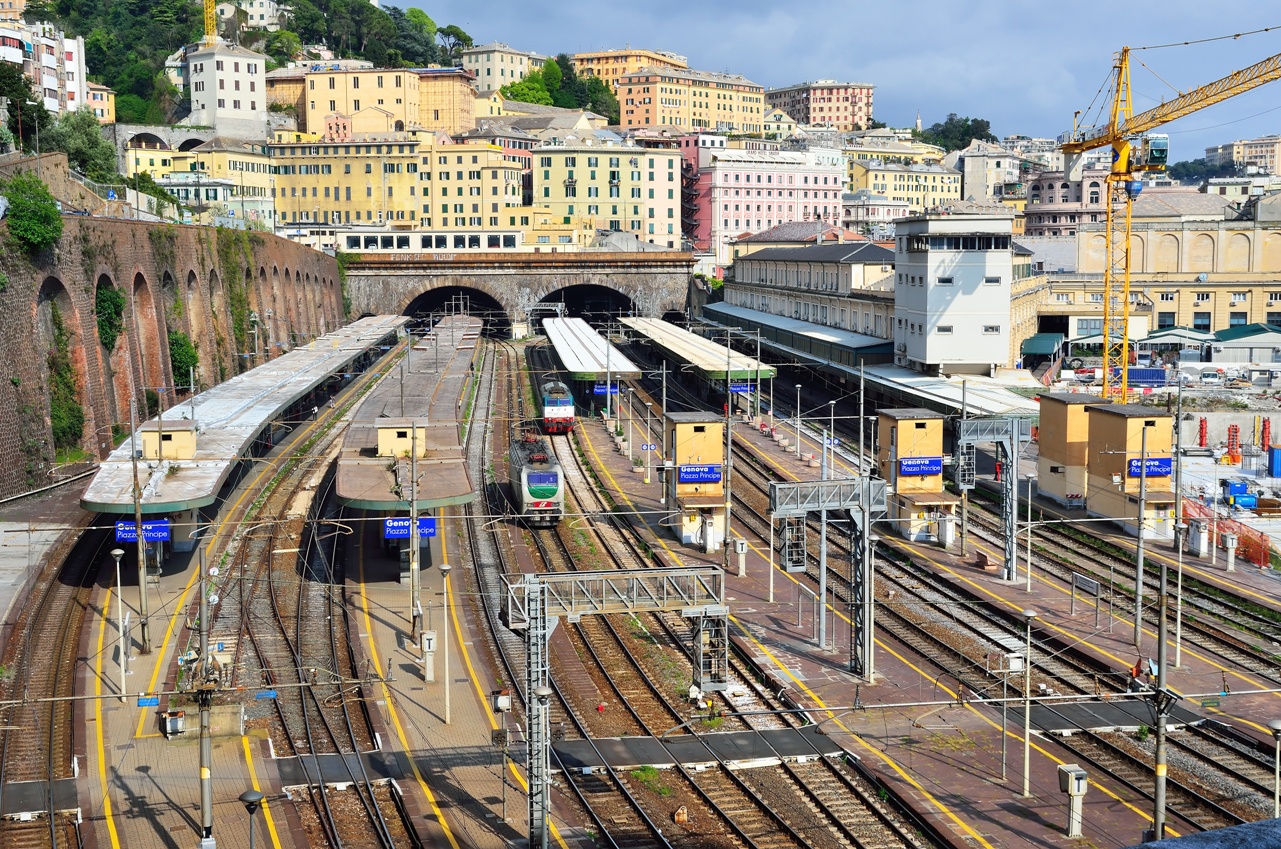19/06/2022 – By Frédéric de Kemmeter – Railway signalling and freelance copywriter – Suscribe my blog
(Version en français)
🟧 Back to homepage 🟧 See our brief news
The Terzo Valico project is a new high-speed line that strengthens the connections of the Genoese port complex with the main railway lines of northern Italy and Europe. It is complemented within the city of Genoa by a reconfiguration of the railway network.
The context
In 2017, the port of Genoa City handled almost 2.7 million TEUs (Twenty-Foot Equivalent Units). The collapse of the Morandini Bridge in August 2018 caused traffic to drop to 1.5 million TEU. Access to the port was at risk due to the lack of a strategic infrastructure for regional mobility, but it was also a warning signal that had repercussions in many areas, starting with employment. In the third quarter of 2018, INPS was already reporting a decrease of 5,000 jobs in Liguria compared to the previous year, explaining this contraction by the bridge collapse, although there may have been other factors at play.
Reversing this negative spiral became the main reason for speeding up the major works needed to connect Genoa to its hinterland and to northern and eastern Europe.
Connection
The objective of Genoa, a large container port but also the 6th largest city in Italy with 575,000 inhabitants, is to be better connected to Lombardy and Piedmont. One of the priorities is to be connected to the Lyon-Turin project and to facilitate access for flows to France, Great Britain and the Benelux countries.
This connection is also part of the Rotterdam-Genoa corridor, which is one of the corridors of the strategic trans-European transport network (TEN-T core network) that links the most densely populated and industrial regions of Europe.
The other priority is rapid access to high-speed rail and to Milan. Italy’s high-speed network is a T-shaped network covering all major Italian cities, with the notable exception of Genoa, which is a very deep conurbation. The topography of the area makes it difficult to build new transport networks without major underground works to the edge of the flatter Lombardy region.
It is interesting to note the priority of focusing on Milan and Turin rather than the country’s capital, Rome, which is admittedly further away.

Two projects
Welcoming the high-speed train and making both regional traffic and international rail freight more fluid implies the implementation of two distinct but closely linked projects:
- The Terzo Valico project, which consists of adding a third line (in yellow) to the two already existing. The Terzo Valico project, which consists of adding a third line (in yellow) to the two existing ones;
- The Nodo di Genova project, which is complementary and consists of a reconfiguration of the tracks between the two major Genoa stations to obtain an optimal separation of mainline / regional / freight flows.
The Terzo Valico project
This is a new high-speed line of 53 kilometres, 37 of which are tunnels, with an additional 18 km of connecting branches. It would be the third rail link between Genoa and the northern valleys, hence the name « Terzo ».
It is designed for mixed traffic with passenger trains running at up to 250 km/h and freight services running at 100 or 120 km/h. The steepest gradient will be 12.5 ‰. The route will be electrified at 3 kV DC with the possibility of later conversion to 25 kV 50 Hz. The line will be equipped with ETCS level 2.
The Genoa-Milan high-speed line will reduce travel time between the two cities by 33% (one hour compared to 1 hour and 29 minutes today).

A long history
The idea for this project dates back to 1990 when a consortium of banks, companies and Ferrovie Nord Milano presented a first proposal. This programme was cancelled in 1998 and the current project is the study version finalised in 2001. Work did not start until 2012 but was frequently called into question as Italian politics changed.
In June 2018 work was halted for the umpteenth time when the newly elected government launched a review of the project to satisfy the election promises of the populist Five Star movement. Works were to resume in 2019 after the publication of the results of a cost-benefit analysis.
To ensure real state support, a ceremony was held in Genoa on 21 July 2020 in the presence of the Prime Minister, in the midst of a pandemic, to mark the resumption of the Terzo Valico rail project, now valued at 6.9 billion euros. Since then, work has been going well.
A major project
Although the line is only 53 kilometres long, the Terzo Valico route crosses mountainous terrain and requires the construction of four tunnels totalling 31.7 kilometres. The longest is the Valico tunnel, which will be 27 kilometres long. To the north, from the Novi Ligure plain, the new line connects to the existing Genoa-Turin lines, for traffic flows to Turin, Novara and Switzerland via the Simplon.
Another connection allows the Tortona – Piacenza line to be joined, for traffic flows to Milan, Switzerland via the Gotthard and also flow towards Verona and Austria. The importance of this work for the city of Genoa is clear.


The Valico tunnel is about 27 km long and has four intermediate access windows. It is a single-track, single-pipe double tunnel, similar to high-speed tunnels such as the Gotthard (completed) or Lyon-Turin (construction underway).
A recent count shows that the breakthrough has reached 80% completion, thanks to a 24/7 construction production system. Completion of the Valico tunnel is scheduled for 2024.
In December 2016, the Saturno consortium was appointed general contractor for electrification and signalling. Hitachi Rail STS is responsible for the signalling and train control system, with its share of the contract amounting to 174∙6 million euros. Colas Rail Italia (formerly Alpiq) is providing electrification, including overhead lines, feeders, substations, auxiliary equipment and remote monitoring systems; the company’s share of the contract amounts to €86∙5m.
Genoa and its network
The Nodo di Genova is part of the Terzo Valico project, but it is also a project in its own right, combining the arrival of high speed and the separation of flows with regional traffic and freight. The whole project covers the Genoa-Voltri-Piazza Principe-Brignole section, as well as providing for the construction of two new tracks between the Porta Principe and Brignole railway junctions.
The bulk of the work is shown on the map below. From the outset, the two stations of Piazza Principe and Brignole have been connected by two underground double-track junctions: Traversata Vecchia and Traversata Nuova, with a total of 4 tracks.
Two other single-track tunnels connect Brignole to the Genova-Maritima freight and port station: San Tomaso and Colombo. Unfortunately, these two single tracks each connect in the Traversata Vecchia and Traversata Nuova. It is the extension of these 2 freight tracks to the station of Brignole that is underway (in red on the map).

To make it even more complex, the extension of the San Tomaso tunnel involves making a curve connecting the two branches of the Grazie Alta/Grazie Bassa Junction. Do you follow?
The final target is to obtain 6 tracks instead of 4 between the two major Genoese stations, differentiating the traffic flows. Genoa can even obtain a kind of RER to Voltri in the west, on a section with 13 stations.
We will come back in more detail to the Genoa railway junction, one of the most complex in Italy.
All in all, a lot of infrastructure in a very constrained environment, offering the city almost 3 lines to reach the north of Italy. Opening in 2024? It is said to be still on the cards.

19/06/2022 – By Frédéric de Kemmeter – Railway signalling
Suscribe my blog


Vous devez être connecté pour poster un commentaire.